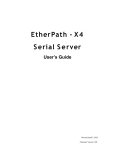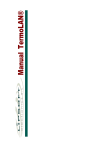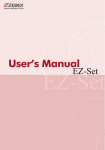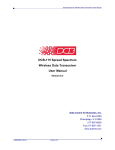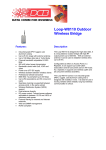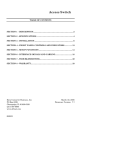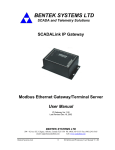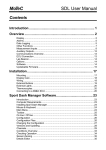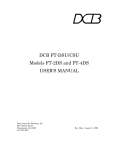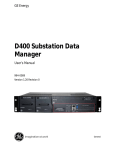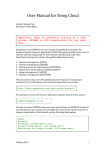Download Link to Manual.
Transcript
EtherPath User’s Guide Revised April 12, 2007 Firmware Version 7.0 FCC Statement This device complies with the limits for a Class B digital device, pursuant to Part 15 of the FCC rules. Operation is subject to the following two conditions: (1) This device may not cause harmful interference. (2) This device must accept any interference received, including interference that may cause undesired operation. CE Marking Warning This is a class B product. In a domestic environment this product may cause radio interference in which case the user may be required to take adequate measures. RoHS Compliant Copyright 1998…2007. All rights reserved. Version 7.x All trademarks and trade names are the properties of their respective owners. TABLE OF CONTENTS FCC Statement........................................................ i CE Marking Warning.............................................. i RoHS Compliant..................................................... i Chapter 1 Introduction.............................................................. 1 EtherPath Functions......................................................2 Client/Server Mode.......................................... 2 Server Mode.................................................... 3 Point-to-Multiple-Point (EtherModem) Mode. 3 Reverse Telnet (Telnet Client) Mode............... 3 Other Features.............................................................. 4 Automatic Connection............................................. 4 AT Commands......................................................... 4 Connection Recovery............................................... 4 Protocol Conversion................................................ 4 Configuration Security............................................. 5 Upgradeable Firmware............................................. 5 Physical Details............................................................ 6 Configuration Switch ............................................ 7 LED Indicators....................................................... 8 Package Contents...................................................9 Software Requirements..........................................9 Chapter 2 Installation.............................................................. 10 Overview.................................................................... 10 i LAN Installation......................................................... 10 1. Connect the Network Cable............................. 10 2. Connect the Power Adapter Cable................... 11 3. Connect the Serial Port Device........................ 11 Chapter 3 Terminal/Telnet Configuration.......................................................... 12 Overview.................................................................... 12 Terminal Configuration.............................................. 13 Procedure.............................................................13 Telnet Configuration.................................................. 14 Terminal/Telnet Interface...........................................16 Entering Data......................................................... 16 Menu Options...................................................... 17 Main Menu Option 1. Setting IP Addresses............................................ 17 1. Local IP Address............................................... 18 2. Remote IP Address............................................ 18 3. Gateway IP Address........................................... 18 4. Subnet Mask...................................................... 18 5. Port Number...................................................... 18 6. IP Fragmentation............................................... 19 7. Operational Mode.............................................. 19 8. Ethernet Mode................................................... 19 7. TCP Tx Timeout................................................ 19 Main Menu Option 2. Set Manager/Telnet IP Address............................ 20 Main Menu Option 3. Set Serial Port Data.............................................. 21 ii Introduction Flow Control......................................................... 22 Baud Rate.............................................................. 22 Parity..................................................................... 22 Data Bits................................................................ 22 Stop Bits................................................................ 22 Pin 6 Control......................................................... 22 Dial Mode.............................................................. 22 RS-485 Mode........................................................ 23 Main Menu Option 4. Advanced Configuration Screen.......................... 24 1. Transmit Timer.................................................. 25 M. Timer Mode..................................................... 25 2. Block Size.......................................................... 25 3. Flow Control OFF Buffer Level........................ 25 4. Flow Control ON Buffer Level.......................... 26 5. Line_Terminator_Character............................... 26 6. Transmit_on_LT_Char...................................... 26 7. Server End-of-Line Filter................................... 26 8. Client Local Character Echo.............................. 27 9. Keep-Alive Frequency...................................... 27 Main Menu Option 5. Display Settings................................................... 28 Current Statistics............................................ 29 Network Packets Received .................................. 29 Network Packets Transmitted................................ 29 Network Packet Errors........................................... 29 Port Bytes Received............................................... 29 Port Bytes Transmitted.......................................... 30 Current Configuration.................................... 30 Switches Status...................................................... 30 iii Current Connection IP Address............................. 30 Main Menu Option 6. Reset Configuration to Default............................ 31 Main Menu Option 7. Save and Exit....................................................... 31 Main Menu Option 8. Security Configuration......................................... 31 Disable Web Configuration................................... 32 Disable Telnet Configuration................................. 32 Disable SNMP Agent............................................ 32 Set User ID and Password..................................... 32 Clear User ID and Password.................................. 32 Main Menu Option 9. SNMP Configuration........................................... 33 Contact Person....................................................... 34 Device Name......................................................... 34 Physical Location.................................................. 34 SNMP Community................................................ 34 Main Menu Option 0. Exit without Saving.............................................. 34 Chapter 4 Browser Configuration.......................................... 35 Overview.................................................................... 35 Connection Procedure................................................ 35 Web-based Interface...................................................37 Port Configuration Screen................................... 38 Flow Control......................................................... 38 Baud Rate.............................................................. 39 Parity..................................................................... 39 iv Introduction Data Bits................................................................ 39 Stop Bits................................................................ 39 Dial Mode.............................................................. 39 RS-485 Mode (Displayed only if jumpered for RS-485)......39 Port Activity Screen.............................................40 Advanced Configuration Screen..........................41 Transmit Timer...................................................... 42 Timer Mode........................................................... 42 Block Size.............................................................. 43 Flow Control OFF Buffer Level............................ 43 Flow Control ON Buffer Level.............................. 43 Line_Terminator_Character................................... 43 Transmit_on_LT_Char.......................................... 43 Server End-of-Line Filter....................................... 44 Client Local Character Echo.................................. 44 Keep-Alive Frequency........................................... 44 LAN Configuration Screen..................................45 Local IP Address................................................... 45 The IP address of this EtherPath device on your LAN. The default IP Address is 192.168.1.1 ......................... 45 Subnet Mask.......................................................... 45 Gateway IP Address............................................... 46 If the remote EtherPath (in “Client/Server” mode) is not on the same LAN, then the gateway to the other LAN must be entered here........................................................... 46 Ethernet Mode....................................................... 46 Remote Device IP Address.................................... 47 Remote (Listen) IP Port Number........................... 47 IP Fragmentation................................................... 47 Port Number.......................................................... 47 v IP Fragmentation................................................... 48 TCP Tx Timeout.................................................... 48 SNMP Configuration Screen............................... 49 Contact Person....................................................... 49 Device Name......................................................... 50 Physical Location.................................................. 50 SNMP Community Name...................................... 50 Configuration Summary Screen...........................51 Chapter 5 Operation................................................................ 52 Client/Server Point-to-Point (Nailed-Up) Mode....... 52 Server Mode............................................................... 54 Client/Server Point-to-Multiple-Point (EtherModem) Mode.. 54 Client (Reverse Telnet) Mode.................................... 57 Method 1 (ATD dial mode)................................... 57 Method 2 (Hardware Dial mode)........................... 58 Chapter 6................................................................. 59 Configuration Security........................................... 59 Overview.................................................................... 59 Level 0: ....................................................................60 Level 1:.......................................................................60 Level 2:.......................................................................61 Level 3:.......................................................................61 Chapter 7 Troubleshooting...................................................... 63 Hardware Problems.................................................... 63 vi Introduction Can't Connect via the LAN........................................65 Other Problems...........................................................67 Checking Device Operation....................................... 69 Appendix A Specifications.......................................................... 70 EtherPath Specifications.............................................70 RS-232 PIN Assignments...........................................71 Control Signal Operation............................................72 DCD...................................................................... 72 Receive Data.......................................................... 72 Transmit Data........................................................ 72 DTR....................................................................... 72 Signal Ground........................................................ 72 DSR....................................................................... 72 RTS....................................................................... 73 CTS....................................................................... 73 Ring Indicator........................................................ 73 CABLES.....................................................................74 To PC 9-pin COM: port................................. 74 SR Mux Composite or Access Switch Input Port......... 74 SS-1 to Modem.............................................. 75 Specialty Cables............................................. 75 Ethernet Cross-Over Cable............................ 75 Appendix B Programming.......................................................... 76 Introduction................................................................ 76 Description and Behavior...........................................77 vii Ports used by the EtherPath................................. 77 Server Mode........................................................ 78 Transmit Conditions.............................................. 78 Locking Avoidance Mechanism........................... 79 When in Raw Server mode:................................... 79 Application Notes.......................................................80 Appendix C AT Command Summary........................................ 81 AT Commands............................................................81 AT Command Responses........................................... 82 AT Command Operation ........................................... 82 Appendix D RS-422/ RS-485 Interface....................................... 83 Introduction................................................................ 83 Changing the Setting............................................83 RS-422 / 4-Wire RS-485 Interface Pinout................. 84 2-Wire RS-485 Interface Pinout.................................85 viii Chapter 1 Introduction This chapter provides an overview of the EtherPath's features and capabilities. C ongratulations on the purchase of your new EtherPath. The EtherPath is a versatile product that enables serial communications devices to operate via Ethernet. It is designed to easily connect a serial port device to your network. A remote PC or other serial device can then be used to monitor, configure, manage and send or receive data to the serial port device through the LAN/WAN. The EtherPath can receive data from any Serial device, convert the data to a valid IP packet, and transmit that data over the LAN/WAN. Serial devices can then be accessed from anywhere on your LAN/WAN by any workstation computer running telnet, dedicated software, or COM: port redirection software. Two EtherPaths may be used in “nailed-up” mode to build a “RS-232 path” through the WAN/LAN. Multiple EtherPaths may be connected via Ethernet by using them in Point-to-Multiple point "AT Dial " mode. Some serial port devices in common use are Bar Code Readers, UPSs, SCADA RTUs, security alarms, access control devices, time clocks, POS terminals, and multiplexers. For easy connection to your LAN, the EtherPath supports both 10BaseT and 100BaseT connections. 1 EtherPath User’s Guide EtherPath Functions The EtherPath can be used in several modes – simple Client/Server or Server, as illustrated below, point-to-multiple-point (EtherModem) Client/Server, and reverse telnet Client. These modes are described below. Figure 1: Modes of Operation Client/Server Mode In this mode, two EtherPaths are used. Both are connected to serial RS-232 devices. This is termed a “Nailed-Up” connection. • The "Client" EtherPath will automatically establish a connection to the "Server" EtherPath upon power-up. • The device on one EtherPath communicates with the other serial port device as if it was directly connected via a serial port cable. • Introduction The EtherPaths and the LAN are completely transparent to PC application and serial port device. Server Mode This mode requires only a single EtherPath. The EtherPath is connected to the serial port device, and to the LAN. Users on the LAN can then connect to the serial port device and communicate with it via Telnet, using any assigned IP and port address. Most LAN connected workstations provide support for communication via Telnet. A special-purpose utility program or port redirector program may be used instead of Telnet, or the user may create custom software using Visual Basic, C++, or other network programming tools. By using port redirection, the EtherPath may function as a remote serial port on a PC. Point-to-Multiple-Point (EtherModem) Mode Point-to-multiple-point (EtherModem) operation allows a single EtherPath running in client mode to connect to multiple servermode EtherPaths, one at a time, under the control of the attached RS-232 device. The client operates similar to a modem with “AT” dialing enabled. The attached device treats the EtherPath as if it was a modem, using remote IP addresses instead of telephone numbers. Reverse Telnet (Telnet Client) Mode This mode requires only a single EtherPath. The EtherPath is connected to the serial port device, and to the LAN. The EtherPath will connect to most remote telnet servers under user control by using “reverse telnet” or telnet client operation. The 3 EtherPath User’s Guide EtherPath will connect to any port number under user control with either hardware (pin6) dialing or AT dialing. By using the "AT Dial" commands, the connected device can direct the EtherPath to connect to multiple remote devices, one at a time. Other Features Automatic Connection When used in Client/Server mode, the “Client” EtherPath will automatically establish a connection to the “Server” EtherPath on power-up, or under the control of an RS-232 control signal. AT Commands The EtherPath responds to most common AT commands when in the Client mode. Commands are listed in the Appendix. Connection Recovery The EtherPath uses a proprietary protocol to ensure the client/server session always exists on TCP/IP. When data hasn't been transferred through the connection for some time, the EtherPath will communicate with the other device (either EtherPath or PC) to ensure that the connection is still open. If there is no response, the device will reset to the initial state, and attempt to reconnect. Also, if the RS-232 link is broken, it will be reconnected automatically if possible (when in Hardware-connect mode). This operation is described in the Appendix. Protocol Conversion The RS-232 device at the client end and the device at the server end of a link do not have to use the same communications protocols on Introduction the RS232 link (speed, parity, flow control). The EtherPaths will convert the data to the correct protocol. Configuration Security Etherpath configuration may be “Locked-down” or restricted in several ways. The web Browser interface, telnet configuration interface, and SNMP configuration interfaces may be disabled. Specific IP addresses may be configured into the unit to disallow configuration from any other than the desired management workstations. Upgradeable Firmware Firmware upgrades are downloadable to the EtherPath. The utility program required for this, and the actual firmware upgrades, are available from your dealer. 5 EtherPath User’s Guide Physical Details The EtherPath front and rear panels are shown below. Figure 1: EtherPath Figure 2: EtherPath Introduction Configuration Switch There is a momentary action push button switch on the rear of the unit behind a small hole. Pressing this switch places the unit in configuration mode and is used only when configuring the EtherPath via the serial port, as explained in Chapter 3 Configuration. Return from configuration mode by exiting the configuration menu or by power cycling the unit. This switch may be depressed with a tiny screw driver or stiff wire. (A straightened paper clip works nicely). Pressing the switch does not return the unit to factory defaults. To return to factory defaults, use any configuration method and select “Set To Defaults” as the command. 7 EtherPath User’s Guide LED Indicators There are three LED indicators on the top panel. • The leftmost LED indicates the unit's current mode. Solid = Server; Off = Client, Flashing= Setup Condition. • The second LED indicates the status of the LAN interface. If it is on, there is a valid LAN connection, Off indicates no LAN connection, and flashing indicates activity on a valid lan connection. A valid LAN connection means a connection from another EtherPath or some other device... not merely being plugged into a hub or switch. • The right most LED flashes along with activity on the RS-232 port. Introduction Package Contents You should find the following items packaged with your EtherPath: • The EtherPath Unit • Power Adapter (typical) • This User’s Guide If any of the above are missing, contact your dealer immediately. Software Requirements The EtherPath supports the following protocols. • TCP/IP • UDP • ARP • ICMP • TELNET • SNMP • AT-Dial The EtherPath has been tested to work with: • All versions of Windows • Unix - SCO, Sun, AIX, Linux, etc. • Macintosh • Most serial devices such as scanners, RTUs, SCADA hosts, alarm controllers, POS devices, PCs, terminals, etc. • VOIP multiplexers, digital video cameras, video conferencing systems, etc. 9 Chapter 2 Installation This Chapter details the LAN installation process for the EtherPath. Overview For Telnet Mode or Web Browser Mode configuration, LAN installation is performed before configuration. There must also be a valid IP address in the unit prior to configuration with these methods. The default IP address may not work with your network. If you use Terminal Mode configuration, then the configuration should be performed prior to LAN installation. See Chapter 3 for details. LAN Installation 1. Connect the Network Cable • The EtherPath network interface is auto-sensing. Simply connect your network cable to the appropriate connector on the EtherPath panel. 10 Configuration 2. Connect the Power Adapter Cable Plug in the power adapter cable. After about a four second boot process the EtherPath is ready for operation. Only use the power adapter provided with the EtherPath. Using a different one may cause hardware damage. 3. Connect the Serial Port Device Connect the serial port device to the serial port on the EtherPath. If connecting to a PC 9-pin port, a cross-over (null modem) cable is required. See the Appendix for wiring details. Then apply power lead to the serial port device. 11 Chapter 3 Terminal/Telnet Configuration This Chapter describes how to configure the EtherPath's using Terminal configuration mode or Telnet configuration mode. Web Browser mode is covered in the next chapter. Overview The EtherPath can be configured using any of the following methods: • Web Browser - After installing the EtherPath in your LAN, use your Web Browser for configuration. See Chapter 4 Browser Configuration for details. • Terminal Mode - Use a serial cable connection and a communication program. The advantage of this method is that you give the EtherPath a compatible IP Address prior to installation in your network. • Telnet Mode - After installing the EtherPath in your LAN, connect to it using Telnet for configuration. Both Terminal and Telnet modes provide the same user interface. 12 Operation Terminal Configuration Terminal configuration requires the following: • PC with terminal emulation program, or a dumb terminal. • Serial cable to connect the PC to the EtherPath. See the Appendix for cable requirements. A Crossover (null modem) cable is required when using a 9 pin PC port. Procedure 1. Connect the EtherPath to your PC or terminal using a nullmodem cable. 2. Press the configuration setup switch momentarily. It is located on the side of the EtherPath and accessed through a small hole. Use a small pen or paper clip to access the switch. 3. Start the terminal program and configure the terminal program with the following settings. Setting Flow control protocol Baud rate Data Parity Stop Bit 4. Value None 9600 8 bits None 1 Connect your terminal program to the appropriate port (e.g. COM 1). 13 EtherPath User’s Guide 5. The configuration program should now start and after a few seconds display a sign-on screen. If nothing appears on your screen, press the Enter key. Refer to Terminal/Telnet Interface on page 16 for details on using the configuration program. Telnet Configuration 1. Install the EtherPath into your LAN as described in Chapter 2. Ensure that the EtherPath is powered on. The EtherPath must have an IP address appropriate for YOUR network. 2. Connect to the EtherPath with your telnet program. An example command might be: telnet IP_Address Port_number Where: IP_Address is the IP address of the EtherPath Port_number (for configuration) is 8000. For example, if the default IP address had not been changed, then you would enter the command: telnet 192.168.1.1 8000 If you can't connect If the EtherPath does not respond, check the following: • The EtherPath is properly installed, LAN connections are OK, and it is powered ON. • Check that your PC is using a compatible IP Address and Network Mask. In Windows9x variations, the IP Address and Network Mask can be checked by using Control Panel-Network 14 Operation to examine the Properties for the TCP/IP protocol. • 3. If your PC is NOT using an IP Address within the range 192.168.1.2 to 192.168.1.254, with a Network Mask of 255.255.255.0, then you must either change the EtherPath's IP address using a directly connected terminal or change your PC to an address in the above range and reboot. Once the PC will communicate with the EtherPath, the EtherPath address may be changed, and the PC reconfigured to its proper address. Refer to the following section for details on using the configuration program. 15 EtherPath User’s Guide Terminal/Telnet Interface The Signon screen displays the version number. EtherPath V5.3 -------------------------------Device Name: GW0000B0 Physical Location: Head Office Operational Mode: SERVER Configuration setup. [Press any key to continue] Pressing any key will then take you to the Main Menu. EtherPath Main Menu -----------------------------------------1 Set Local & Remote IP Address, Subnet Mask, and Gateway Address 2 Set Manager/Telnet IP Address 3 Serial Port Configuration 4 Advanced Configuration 5 Display Configuration Settings 6 Reset Configuration to Default 7 Save and Exit 8 Security Configuration 9 SNMP Configuration 0 Exit without Saving Choose a Number => Each of these menu options is explained in the following pages. Entering Data Enter the number of the field you wish to change, followed (on the same line) by a space and the data for that field. For example: On screen one, to set the IP address (field 1) to 192.168.1.10 => 16 1 192.168.1.10 Operation Menu Options Main Menu Option 1. Setting IP Addresses Selecting 1 ( 1. Set Local & Remote IP Address, Subnet Mask, Gateway Address ) from the Main Menu will result in a screen which looks like the following. LOCAL UNIT CONFIGURATION: Local Address: 205.166.54.216 Serial NO: 00:09:AA:00:00:B0 Remote Address: (NOT SET) Gateway Address: (NOT SET) Subnet Mask: 255.255.255.0 Server Mode - Listen on Port: 3000 IP Fragmentation: ALLOWED Ethernet Mode: Auto TCP Tx Timeout: ENABLED SET LOCAL UNIT CONFIGURATION: 1 Local IP Address 2 Remote IP Address 3 Gateway IP Address 4 Subnet Mask 5 Port Number 6 IP Fragmentation [0=ALLOWED, 1=NOT ALLOWED] 7 Operational Mode [0=Server, 1=Client, 2=Telnet Server, 3=Telnet Client] 8 Ethernet Mode [0=Auto, 1=100Mb-Full, 2=100MbHalf, 3=10Mb-Full, 4=10MB-Half] 9 TCP Tx Timeout [0=Enabled, 1=Disabled] 0 -- Return to previous menu Enter Command => 17 EtherPath User’s Guide 1. Local IP Address The IP address of this EtherPath device on your LAN. The default IP Address is 192.168.1.1 2. Remote IP Address In “Client” mode, this is the IP address of the remote “Server” device which this client will automatically connect to when powered up (if RS-232 PIN 6 is high or forced) and configured for hardware dialing. This is also the default server that will be used for AT dialing when in PMP mode. In “Server” mode, this value is not required, and will be ignored. 3. Gateway IP Address If the remote device this unit communicates with is not on the same LAN, then the gateway to the other LAN must be entered here. 4. Subnet Mask The network mask indicates what class of TCP/IP network you have. The default value is for a class “C” network, with up to 255 users. This value should work in small networks. If in doubt, consult your network administrator. 5. Port Number This is the TCP/IP port number the EtherPath listens on when in server mode. The default is port 3000. When in client mode, this is the port on the remote server that a connection is attempt with. This value may be overridden when in Ethermodem mode by including a port number in the ATD command. 18 Operation 6. IP Fragmentation If set to ZERO, IP blocks sent from this EtherPath may be fragmented in transit, and blocks may be fragmented by the EtherPath. If set to ONE, the 'DONTFRAG' bit is set in IP packets, and all blocks are transmitted intact. This is normally set to 0 , but is set to 1 for some SCADA applications. The default is 0. 7. Operational Mode Server and Client modes provide a raw data path and should be selected when two EtherPaths are used in a nailed up configuration. This is often named “raw sockets” mode and is transparent to the data being transported. Telnet Server and Telnet Client modes perform Telnet command processing and should be used when an EtherPath is communicating directly with a Host Telnet Client or Server. 8. Ethernet Mode The EtherPath ethernet interface may be configured as 10Mbps or 100Mbps, half or full duplex; or AUTO. The default of AUTO is most commonly used. If hard configured, insure that the hub or switch matches the mode selected. 7. TCP Tx Timeout When enabled, the local unit will close the connection if it is unable to deliver data to the remote unit. The timeout is dependent upon the round-trip time, but will be in the range of 5 to 12 minutes. When disabled, the unit will try forever to deliver the data. 19 EtherPath User’s Guide Main Menu Option 2. Set Manager/Telnet IP Address Selecting (2) from the Main Menu will result in the following screen. Entry Manager_IpAddr ***** *************** 1. 000.000.000.000 2. 000.000.000.000 3. 000.000.000.000 4. 000.000.000.000 MANAGER SETUP: set Entry_Number IP_Address clear Entry_Number 0 --Return to main menu. EXAMPLE: to set entry #3 to IP address=138.239.0.24, => set 3 138.239.0.24 to clear entry #2 IP address, => clear 2 Enter Command => This screen shows a table containing four (4) entries. By default, all entries are blank. These entries provide a security feature. Only a user at one of the IP addresses shown can configure the EtherPath. (All users on the LAN can still access the EtherPath, but not configure it.) If the entries are blank, then any user on the LAN can configure the EtherPath. If you are not sure about using this feature, leave the addresses all zeros. Entries in the table cannot be edited, but commands are provided to insert (SET) and delete (CLEAR) entries. 20 Operation Main Menu Option 3. Set Serial Port Data Selecting (3) from the Main Menu will result in the following screen. PORT CONFIGURATION: Flow Control: NONE Baud Rate: 9600 Data: 8 Bits Parity: NONE Stop: 1 Bit Pin 6 Control: FORCED ON Client Dial Mode: HARDWARE (Pin 6) RS485: 4-wire (Jumpers set for RS232) SET PORT CONFIGURATION: 1 Flow Control [0=None, 1=XON/XOFF, 2=RTS/CTS, 3=RTS Toggle] 2 Baud Rate [0=230400, 1=115200, 2=57600, 3=38400, 4=19200, 5=9600, 6=4800, 7=2400, 8=1200, 9=600, 10=300] 3 Parity bit [0=None, 1=Odd, 2=Even] 4 Data bits [0=7bits, 1=8bits] 5 Stop bits [0=1bit, 1=2bits] 6 Pin 6 Control [0=From Interface, 1=Forced ON] 7 Dial Mode [0=ATD, 1=Hardware (Pin 6)] 8 RS485 Mode [0=4-wire, 1=2-wire] 0 -- Return to previous menu. EXAMPLE: To set the baud rate to 19200 => 2 4 Enter Command => This screen allows you to change the settings for the RS232 link. The settings used should match the device connected to the serial port of the EtherPath. Note that the EtherPath's serial settings must match the device that is plugged into THAT EtherPath. The device at the other end of the Ethernet link may be set differently. 21 EtherPath User’s Guide Flow Control The choices are “None”, “XON/XOFF”, and “RTS/CTS”. It is common to use NONE for installation troubleshooting, then set it correctly to match the connected device. If RTS/CTS is used, the cables must have handshake lines wired correctly. RTS Toggle is a handshake mode commonly used with half duplex modems. The RTS output is asserted when the unit has data to transmit and it will remain asserted for approximately 5ms after the last character has been transmitted. The CTS signal controls output flow. Baud Rate Speeds between 300 bps and 230.4Kbps are supported. Parity The choices are “None”, “Odd”, or “Even”. Data Bits The choices are 7 or 8. This does NOT include the parity bit. The two most common settings are 7 bit PLUS appropriate parity or 8 bit with NO parity. Default is 8 bits. Stop Bits The choices are 1 or 2. Commonly use 1. Pin 6 Control If Forced On, the EtherPath responds as if interface pin 6 is always high. If From Interface, its condition is a read from the RS-232 cabling must be correct for proper operation. Dial Mode The choices are “ATD” or “Hardware”. This configures the EtherPath, when in client mode, to connect to a remote device when it receives an asserted hardware (pin 6) signal or when it receives 22 Operation an “ATD” command. For a full-time Nailed-up connection, use Hardware. See Chapter 5, Point-to-Multiple-Point-Mode for use of the "AT" setting. RS-485 Mode Select between 4-wire full duplex and 2-wire half duplex RS-485 mode. For RS-485 operation, the hardware jumpers inside the unit must be moved from the RS232 to the RS485 position. This setting is ignored when using RS-232. 23 EtherPath User’s Guide Main Menu Option 4. Advanced Configuration Screen Selecting (4) from the Main Menu will display the following: ADVANCED CONFIGURATION: Transmit Timer: 10 ms (Mode: IDLE TIMEOUT) Block Size: 512 Bytes Flow OFF Buffer Level: 80% Flow ON Buffer Level: 20% Line Terminator Character: 13 (Dec) Transmit on LT Char: OFF Server End-of-Line Filter: ON Client Local Character Echo: OFF Keep-Alive Frequency: 0 seconds SET ADVANCED CONFIGURATION: 1 Transmit Timer [min=1ms, max=10000ms] M Timer Mode [0=transmit timer, 1=idle timeout] 2 Block Size [min=1byte, max=4096bytes] 3 Flow Control OFF Buffer Level [min=1%, max=99%] 4 Flow Control ON Buffer Level [min=1%, max=99%] 5 Line Terminator Character [min=0, max=255] 6 Transmit on LT Character [0=OFF, 1=ON] 7 Server End-of-Line Filter [0=OFF, 1=ON] 8 Client Local Character Echo [0=OFF, 1=ON] 9 Keep-Alive Frequency [0=OFF, 1-32767 seconds] 0 -- Return to previous menu EXAMPLE: To set the Flow OFF level to 75% => 3 75 Enter Command => The EtherPath has a built-in buffer to store data. Most of these settings affect the operation of the buffer and how data is buffered and transmitted over the Ethernet. The default values should normally be satisfactory, but they may be "tuned" for optimum operation. Note: Options 5, 6, 7, and 8 apply to Client Mode only, and have no effect in Server Mode. 24 Operation 1. Transmit Timer When in Timer Mode: The time period for which data will be stored in the buffer before being sent. Allowable values range from 1ms to 10,000ms (10 seconds). A commonly used value is 20 msec. When in Idle Timeout Mode: The time period this unit's port must be idle (after receiving a character) before sending a block of data via the Ethenet. This is used to keep incoming blocks of data intact. It is useful for some protocols such as Modbus RTU. Its setting depends upon the port speed, and should be several character times.. Allowable values range from 1ms to 10,000msec (10 seconds). A typical value for a 9.6 Kbps port is about 3 msec. M. Timer Mode When set to 0, the timer is a free-running clock and if there is data in the buffer, an IP packet is transmitted every TIMER msec. When set to 1, the timer is a serial port idle time value. If there is data in the buffer and the serial port has been idle for TIMER msec, then an IP packet is transmitted. 2. Block Size The maximum ethernet packet buffer size. The minimum value is 1 byte, the maximum 4096 bytes (4 K). Typical values are either in a low range of 10-20 characters for polling applications or very large in the range of 500 to 1500 for file transfer applications. Normally, the timer triggers a packet transmission before the block fills. If the buffer contains BLOCKSIZE characters, an IP packet is transmitted regardless of the timer mode and settings. 3. Flow Control OFF Buffer Level If the amount of data stored in the buffer reaches this point, and the EtherPath is unable to transmit the data, then no further input will be accepted. 25 EtherPath User’s Guide Under normal operation, this will not happen. This is normally left at the default value. 4. Flow Control ON Buffer Level Once the High_Water mark has been reached, the “no-input accepted” mode will continue until the EtherPath has transmitted enough data to reduce the buffer contents to this point. This is normally left at the default value. 5. Line_Terminator_Character This setting is used to change the Line Terminator Character. The Line Terminator Character causes any data in the buffer to be transmitted immediately the character is received, provided: This is the binary value of the trigger charaacter. • The EtherPath is being used in “Client” mode. • The following setting (Transmit_on_LT_Char) is ON. 6. Transmit_on_LT_Char When this setting is ON, any data in the buffer will be sent immediately upon receipt of a Line_Terminator_Character (see previous setting). When the setting is OFF, the Line_Terminator_Character has no effect. In “Server” mode, this setting has no effect. 7. Server End-of-Line Filter This setting can turn the filter function ON or OFF. If ON, then when a CR/LF (Carriage Return, Line Feed) character pair is received, it is converted to a CR only before it is sent to the serial port output. CR/LF pairs are normally used in the MS-DOS environment to mark the end of a line, but may cause problems in other environments. CR/NULL character pairs are also converted to a CR only. 26 Operation • If this setting is OFF, then no conversion is done. • In "Client Mode", this setting has no effect. 8. Client Local Character Echo If ECHO is ON, the client EtherPath will locally echo all incoming characters in client mode. If ECHO is OFF, the client EtherPath will not echo characters or transmit any status messages to the serial port. This mode should be used if any messages from the EtherPath would create interference. OFF is the most commonly used value. 9. Keep-Alive Frequency Setting this parameter to a non zero value will enable a Keep-Alive feature in the Unit. When the Unit is in Client or Telnet Client mode, it will send Keep-Alive messages to the server at the specified frequency when the link between the client and server is idle. When the Unit is in Server or Telnet Server mode, it will close the connection if the link is idle for more than 3.5 times the KeepAlive Frequency. [0=OFF, 1-32767 seconds] 27 EtherPath User’s Guide Main Menu Option 5. Display Settings Selecting (5) from the Main Menu displays a screen like the following example. LOCAL UNIT CONFIGURATION: Local Address: 205.166.54.216 00:09:AA:00:00:B0 Remote Address: (NOT SET) Gateway Address: (NOT SET) 255.255.255.0 Server Mode - Listen on Port: 3000 IP Fragmentation: ALLOWED Ethernet Mode: Auto TCP Tx Timeout: ENABLED Serial NO: Subnet Mask: SNMP CONFIGURATION: Name of Contact Person: Supervisor Device Name: GW0000B0 Physical Location: Head Office SNMP Community: public MANAGER Entry ***** 1. 2. 3. 4. CONFIGURATION: Manager_IP_Addr *************** 0.0.0.0 0.0.0.0 0.0.0.0 0.0.0.0 PORT CONFIGURATION: Flow Control: NONE Baud Rate: 9600 Data: 8 Bits Parity: NONE Stop: 1 Bit Pin 6 Control: FORCED ON Client Dial Mode: HARDWARE (Pin 6) RS485: 4-wire (Jumpers set for RS232) ADVANCED CONFIGURATION: Transmit Timer: 20 ms (Mode: TRANSMIT TIMER) Block Size: 512 Bytes Flow OFF Buffer Level: 80% Flow ON Buffer Level: 20% Line Terminator Character: 13 (Dec) Transmit on LT Char: OFF 28 Operation Server End-of-Line Filter: OFF Client Local Character Echo: OFF Keep-Alive Frequency: 0 seconds CURRENT ETHERPATH STATISITCS: Network packets received: 12 Network packets transmitted: 8 Network packet errors: 0 Port bytes received: 4 Port bytes transmitted: 0 CURRENT ETHERPATH CONFIGURATION: SERVER Mode Connected to IP Address: (NO ACTIVE CONNECTION) [Press any key to continue] Note that no data can be changed. Pressing any key from the above screen will return you to the Main Screen. All data items except the following have been explained on the preceding pages. Current Statistics Network Packets Received Number of packets received by the EtherPath through the LAN connection. Network Packets Transmitted Number of packets transmitted by the EtherPath through the LAN connection. Network Packet Errors Number of packets received through the LAN connection which contained errors. Port Bytes Received Number of Characters received through the serial (RS232) connection. 29 EtherPath User’s Guide Port Bytes Transmitted Number of Characters transmitted through the serial (RS232) connection. Current Configuration Switches Status Current setting of the DIP Switches. Current Connection IP Address The IP address of thedevice (PC, terminal, or remote EtherPath) to which the EtherPath is currently connected through the LAN link. If it is not connected, this field will display “No active connection”. 30 Operation Main Menu Option 6. Reset Configuration to Default Selecting (6) from the Main Menu will restore all values to their defaults. If using Telnet, the connection will be lost when the EtherPath reboots. To reconnect, you must connect to the default IP Address of 192.168.1.1 or change the EtherPath IP address to one that is appropriate for your network before rebooting with main menu option 7. Main Menu Option 7. Save and Exit Selecting (7) from the Main Menu will store the configuration details in the EtherPath, and exit the configuration program. If using Telnet, the connection will be lost when the EtherPath reboots. If you have changed the IP Address, you must use the new IP Address when you reconnect. Using option 7 when there were no changes made is one way to effect a cold reboot on a remote EtherPath. Main Menu Option 8. Security Configuration Selecting (8) from the Main Menu will display the security configuration screens. 31 EtherPath User’s Guide SET SECURITY CONFIGURATION: 1 Disable Web Configuration [0=ENABLED, 1=DISABLED] 2 Disable Telnet Configuration [0=ENABLED, 1=DISABLED] 3 Disable SNMP Agent [0=ENABLED, 1=DISABLED] 4 Set User ID and Password [index userid password] 5 Clear User ID and Password 0 -- Return to previous menu EXAMPLE: To set User ID 1 to root, password toor => 4 1 root toor Enter Command => Set Security Configuration Screen Disable Web Configuration The web configuration may be turned off. If set to disabled, the unit will not answer to web browser inquires. Disable Telnet Configuration If disabled, the unit will not answer telnet connection requests on port 8000, and the only configuration method will be direct terminal connection Disable SNMP Agent If disabled, the unit will not respond to SNMP traps and gets Set User ID and Password Used to establish user names and passwords. Clear User ID and Password Clears existing user names and passwords The EtherPath uses the industry standard IP protocol. Since this is a well known standard, its security vulnerabilities are also well known and may be exploited. Several EtherPath options are available to 32 Operation enhance the inherent security of your EtherPath network. However, since network security is a moving target and absolute security is never achievable, every network installation should be designed and implemented with care to minimize security risks in a way that is appropriate for the application and perceived risks. The EtherPath may be configured with several levels of security configuration and authentication. These restrict the ability of an unwanted user from changing the configuration of the EtherPathl. They do not restrict the ability of a remote device to deliver packets to the EtherPath's data port. Before starting configuration security, you should be familiar with the information in chapter 5. Main Menu Option 9. SNMP Configuration Selecting (9) from the Main Menu will display the SNMP configuration screen. SNMP CONFIGURATION: Name of Contact Person: Supervisor Device Name: GW0000B0 Physical Location: Head Office SNMP Community: public SET 1 2 3 4 0 SNMP CONFIGURATION: Name of Contact Person Device Name Physical Location SNMP Community -- Return to previous menu Enter Command => 33 EtherPath User’s Guide Contact Person This text field can be used to store the name of the person responsible for the Serial Port Device. Device Name This can be used to store a descriptive name for the device. Physical Location This can be used to store he location of the device. SNMP Community The SNMP community name. Default is “public”. Main Menu Option 0. Exit without Saving Selecting (0) from the Main Menu will exit the configuration program without saving any data you have entered. If you changed the IP address, this will force the unit to restart using the new address. 34 Operation Chapter 4 Browser Configuration This Chapter describes how to configure the EtherPath using a Web Browser. The EtherPath must have an IP address appropriate to your network before using this method. Overview This configuration method uses your Web Browser to configure the EtherPath. This provides the most user-friendly interface than the Telnet/Terminal method. • The EtherPath must be installed in your LAN before this configuration method can be used. • Most Browsers will work. The only requirement is that they support HTML tables and forms. Connection Procedure To establish a connection to the EtherPath, follow this procedure: 1. Install the EtherPath in your LAN as described in Chapter 2. Ensure that the EtherPath is powered on. 4. Start your Web browser. 5. In the Address box, enter the following: http://IP_Address 35 EtherPath User’s Guide (IP_Address is the IP address of the EtherPath) For example, http://192.168.1.1 If you can't connect If the EtherPath does not respond, check the following: • The EtherPath is properly installed, LAN connections are OK, and it is powered ON. • Check that your PC is using a compatible IP Address and Network Mask. In Windows9x variations, the IP Address and Network Mask can be checked by using Control Panel-Network to examine the Properties for the TCP/IP protocol. • If your PC is NOT using an IP Address within the range 192.168.1.2 to 192.168.1.254, with a Network Mask of 255.255.255.0, then you must either change the EtherPath's IP address using a directly connected terminal or change your PC to an address in the above range and reboot. Once the PC will communicate with the EtherPath, the EtherPath address may be changed, and the PC reconfigured to its proper address. • Insure that your browser isn't using a proxy server. If it is, configure the browser to not use the proxy for the EtherPath's IP address. (This may not work in Internet Explorer and you might have to temporarily disable using the proxy server) 6. 36 Once connected, you will see the first screen. Refer to the following section for details on using the Web-based interface. Operation Web-based Interface The first screen is similar to Figure 2. Figure 2: Sign on Screen • Use the menu bar on the left to navigate to the desired screen. • On-line help is available on each screen. • Each screen is explained in the following sections. 37 EtherPath User’s Guide Port Configuration Screen Figure 3: Port Configuration Screen This screen allows you to change the settings for the RS232 link. The settings used should match the device connected to the serial port of the EtherPath. Note that the EtherPath's serial settings must match the device that is plugged into THAT EtherPath. The device at the other end of the Ethernet link may be set differently. Flow Control The choices are “None”, “XON/XOFF”, and “RTS/CTS”. It is common to use NONE for installation troubleshooting, then set it correctly to match the connected device. If RTS/CTS is used, the RS-232 cables must have handshake lines wired correctly. RTS Toggle is a handshake mode commonly used with half duplex modems. The RTS output is asserted when the unit has data to 38 Operation transmit and it will remain asserted for approximately 5ms after the last character has been transmitted. The CTS signal controls output flow. Baud Rate Speeds between 300 bps and 230.4Kbps are supported. Parity The choices are “None”, “Odd”, or “Even”. Data Bits The choices are 7 or 8. This does NOT include the parity bit. The two most common settings are 7 bit PLUS appropriate parity or 8 bit with NO parity. Stop Bits The choices are 1 or 2. Commonly use 1. Dial Mode The choices are “ATD” or “Hardware”. This configures the EtherPath, when in client mode, to connect to a remote device when it receives an asserted hardware (pin 6) signal or when it receives an “ATD” command. For a full-time Nailed-up connection, use Hardware. See Chapter 5, Point-to-Multiple-Point-Mode for use of the "AT" setting. RS-485 Mode (Displayed only if jumpered for RS-485) Select between 4-wire full duplex and 2-wire half duplex RS-485 mode. For RS-485 operation, the hardware jumpers inside the unit must be moved from the RS232 to the RS485 position. This setting is ignored when using RS-232. 39 EtherPath User’s Guide Port Activity Screen Figure 4:Port Activity Screen This screen displays details about the data currently being transmitted or received, either through the LAN or Serial port. The display is updated every 10 seconds. Data - Network Current The IP Address of the remote to device to which Connection this EtherPath is currently connected IP Address: Packets received: 40 Number of packets received by the EtherPath through the LAN connection including management screen packets. Operation Packets Number of packets transmitted by the EtherPath Transmitted through the LAN connection, including management screen updates. Packet Errors Number of packets containing errors transmitted or received by the EtherPath through the LAN connection. Under normal conditions, this should be 0. Data - Serial Port Bytes Received Number of Bytes received, through the serial (RS232) connection, from the Serial port device Bytes Number of Bytes transmitted through the serial (RS232) connection to the Serial port device (or Transmitted PC, if in Client mode). Advanced Configuration Screen Figure 5: Advanced Configuration Screen 41 EtherPath User’s Guide The EtherPath has a built-in buffer to store data. Most of these settings affect the operation of the buffer and how data is buffered and transmitted over the Ethernet. The default values should normally be satisfactory for most installations, but they may be "tuned" for optimum operation. Note: Options 5, 6, 7, and 8 apply to Client Mode only, and have no effect in Server Mode. Transmit Timer When in Timer Mode: The time period for which data will be stored in the buffer before being sent. Allowable values range from 1ms to 10,000ms (10 seconds). A commonly used value is 20 msec. For example, in this mode, every 20 msec, the buffer will be transmitted if there is any data in it. When in Idle Timeout Mode: The time period this unit's serial port must be idle (after receiving a character) before sending a block of data via the Ethenet. This is used to keep incoming blocks of data intact. It is useful for some protocols such as Modbus RTU. Its setting depends upon the port speed, and should be several character times.. Allowable values range from 1ms to 10,000msec (10 seconds). A typical value for a 9.6 Kbps port is about 3 msec. For example, in this mode, if there is data in the buffer and 3 msec. passes with no additional data being received, the buffer is transmitted. Timer Mode When set to 0, the timer is a free-running clock and if there is data in the buffer, an IP packet is transmitted every TIMER msec. When set to 1, the timer is a serial port idle time value. If there is data in the buffer and the serial port has been idle for TIMER msec, then an IP packet is transmitted. 42 Operation Block Size The maximum Ethernet packet buffer size. The minimum value is 1 byte, the maximum 4096 bytes (4 K). Typical values are either in a low range of 10-20 characters for polling applications or very large in the range of 500 to 1500 for file transfer applications. Normally, the timer triggers a packet transmission before the block fills. If the buffer contains BLOCKSIZE characters, an IP packet is transmitted. This setting is rarely changed from the default. Flow Control OFF Buffer Level If the amount of data stored in the buffer reaches this point, and the EtherPath is unable to transmit the data, then no further input will be accepted. Under normal operation, this will not happen. This is normally left at the default value. Flow Control ON Buffer Level Once the High_Water mark has been reached, the “no-input accepted” mode will continue until the EtherPath has transmitted enough data to reduce the buffer contents to this point. This is normally left at the default value. Line_Terminator_Character This setting is used to change the Line Terminator Character. The Line Terminator Character causes any data in the buffer to be transmitted immediately the character is received, provided: This is the binary value of the trigger character. • The EtherPath is being used in “Client” mode. • The following setting (Transmit_on_LT_Char) is ON. Transmit_on_LT_Char When this setting is ON, any data in the buffer will be sent immediately upon receipt of a Line_Terminator_Character (see 43 EtherPath User’s Guide previous setting). When the setting is OFF, the Line_Terminator_Character has no effect. In “Server” mode, this setting has no effect. Server End-of-Line Filter This setting can turn the filter function ON or OFF. If ON, then when a CR/LF (Carriage Return, Line Feed) character pair is received, it is converted to a CR only before it is sent to the serial port output. CR/LF pairs are normally used in the MS-DOS environment to mark the end of a line, but may cause problems in other environments. CR/NULL character pairs are also converted to a CR only. • If this setting is OFF, then no conversion is done. • In "Client Mode", this setting has no effect. Client Local Character Echo If ECHO is ON, the client EtherPath will locally echo all incoming characters in client mode. If ECHO is OFF, the client EtherPath will not echo characters or transmit any status messages to the serial port. This mode should be used if any messages from the EtherPath would create interference. OFF is the most commonly used value. Keep-Alive Frequency Setting this value to a non-zero value will enable a Keep-Alive feature in the unit. When the unit is in Client or Telnet Client mode, It will send Keep-Alive messages to the server at the specified frequency if there is no other traffic on the link . The default is normally appropriate, but for low-bandwidth links, the keep-alive packets may be sent less often. In rare cases, it is turned off by setting the value to zero. 44 Operation LAN Configuration Screen Figure 6: LAN Configuration Screen This screen allows you to set all data relating to your LAN. Local IP Address The IP address of this EtherPath device on your LAN. The default IP Address is 192.168.1.1 Subnet Mask The network mask indicates what class of TCP/IP network you have. The default value is for a class “C” network, with up to 255 users. This value should work in small networks. If in doubt, consult your network administrator. 45 EtherPath User’s Guide Gateway IP Address If the remote EtherPath (in “Client/Server” mode) is not on the same LAN, then the gateway to the other LAN must be entered here. Mode Server and Client modes provide a raw data path and should be selected when two EtherPaths are used in a nailed up configuration. This is often named “raw sockets” mode and is transparent to the data being transported. Telnet Server and Telnet Client modes perform Telnet command processing and should be used when an EtherPath is communicating directly with a Host Telnet Client or Server. Ethernet Mode Although most often used in auto-configure mode, the EtherPath may be forced to 10Mbps, 100Mbps, half, or full duplex. This option is useful when connected to a switch that is very slow powering up. The EtherPath powers up fairly quickly, and may be forced to a compatible mode to prevent it from negotiating an invalid configuration with a hub or switch that isn’t initialized to negotiate. Administrator Access Rights If the entries are blank, then any user on the LAN may configure the EtherPath. If you are not sure about using this feature, leave the addresses all zeros. This screen shows a table containing four (4) entries. By default, all entries are blank. These entries provide a security feature. Only a user at one of the IP addresses shown can configure the EtherPath. (All users on the LAN can still access the EtherPath, but not configure it.) Read the security chapter before implementing this feature. 46 Operation Remote Device IP Address In “Client” mode, this is the IP address of the remote “Server” device which this client will automatically connect to when powered up (if RS-232 PIN 6 is high or forced) and configured for hardware dialing. This is also the default server that will be used for AT dialing when in PMP mode. In “Server” mode, this value is not required, and will be ignored. Remote (Listen) IP Port Number This is the TCP/IP port number the EtherPath listens on when in server mode. The default is port 3000. When in client mode, this is the port on the remote server that a connection is attempted with. This value may be overridden when in Ethermodem mode by including a port number in the ATD command. See Appendix B for a discussion of the sending IP port number. IP Fragmentation If set to ZERO, IP blocks sent from this EtherPath may be fragmented in transit, and blocks may be fragmented by the EtherPath. If set to ONE, the 'DONTFRAG' bit is set in IP packets, and all blocks are transmitted intact. This is normally set to 0 , but is set to 1 for some SCADA applications. The default is 0. Port Number This is the TCP/IP port number the EtherPath listens on when in server mode. The default is port 3000. When in client mode, this is the port on the remote server that a connection is attempt with. This value may be overridden when in Ethermodem mode by including a port number in the ATD command. 47 EtherPath User’s Guide IP Fragmentation If set to ZERO, IP blocks sent from this EtherPath may be fragmented in transit, and blocks may be fragmented by the EtherPath. If set to ONE, the 'DONTFRAG' bit is set in IP packets, and all blocks are transmitted intact. This is normally set to 0 , but is set to 1 for some SCADA applications. The default is 0. TCP Tx Timeout When enabled, the local unit will close the connection if it is unable to deliver data to the remote unit. The timeout is dependent upon the round-trip time, but will be in the range of 5 to 12 minutes. When disabled, the unit will try forever to deliver the data. This is normally used in the default enabled mode. It is sometimes turned off to operate better with satellite Internet provider TCP ACK spoofing. 48 Operation SNMP Configuration Screen Figure 7: SNMP Configuration Screen Overview This screen may be ignored if SNMP is not used. These are text fields, commonly used in SNMP (Simple Network Management Protocol) Programs to identify this device when browsing the network. Other standard MIB values are returned to the SNMP manager along with this information. Contact Person This text field can be used to store the name of the person responsible for the Serial Port Device. 49 EtherPath User’s Guide Device Name This can be used to store a descriptive name for the device. Physical Location This can be used to store he location of the device. SNMP Community Name The SNMP community name. The default is “public”. 50 Operation Configuration Summary Screen Figure 8:Configuration Summary Screen Operation • This screen displays all current settings for this EtherPath • Clicking the "Set to Defaults" button will restore ALL values to their factory default values. When this is done, the EtherPath will reboot, and the existing connection will be lost. You must reconnect using the default IP Address of 192.168.1.1. 51 Chapter 5 Operation This Chapter explains how to use the EtherPath, once it is installed and configured. Although it may be used with automated equipment such as RTUs, POS, or other computer-based devices; the example configurations shown in this chapter use terminals or terminal emulation on a PC for illustrations. It is often useful to set up the EtherPath using this method before connecting other equipment. Client/Server Point-to-Point (Nailed-Up) Mode • Both EtherPaths must be correctly installed and configured as described in Chapters 3 or 4. One serial port device is connected to the “Server” EtherPath, and another serial device is connected to the “Client” EtherPath. One EtherPath has the operational mode set as a "Server", the other has the operational mode set as a "Client". • The communication settings for the serial devices must be the same as the values entered into the EtherPath device they each attach to. • Power up the "server" EtherPath. • Power up the "client" EtherPath. It will automatically connect to the remote EtherPath whose IP address was stored during 52 Operation configuration if hardware dialing is enabled and pin 6 is asserted. • You may now proceed as if the remote serial port device was directly connected to the serial port of your local serial device. • If Pin 6 control is set to From Interface, then the serial device must provide a high level signal on pin 6 before the EtherPath will accept or place an Ethernet connection. 53 EtherPath User’s Guide Server Mode • Install and connect the EtherPath and Serial Port Device as described in Chapters 3 and 4. • Any PC or workstation on the LAN/WAN should now be able to use Telnet to connect to the Serial Port Device with the command: telnet IP_Address Port_number Where IP_Address is the IP address of the EtherPath, and Port_number is the configured value (default value is 3000). For example, if the default IP address and port number have not been changed (and they are appropriate for your network), then you would enter the command: telnet 192.168.1.1 3000 • You should see a “Connected” message from the telnet client when the connection is established. Some telnet clients don’t display this message. • You may now proceed as if the remote serial port device was connected to the serial port of your PC or workstation. • If there is a firewall in the link between the EtherPath and your workstation, you may need to configure it to pass packets using the port number configured into the EtherPath. Client/Server Point-to-Multiple-Point (EtherModem) Mode • 54 EtherModem mode requires multiple EtherPaths configured in “Server” mode and a single EtherPath configured in “Client” Operation mode. Under user control with "AT" commands, the “Client” connects to multiple “Servers”, one at a time similar to the way a dial-up modem would. "Server" and "Client" refer to the operational mode settings of the EtherPath. • All EtherPaths must be connected as described in Chapters 3 and 4. One serial port device is connected to each “Server” EtherPath, and additional serial devices (usually a workstation) are connected to the “Client” EtherPaths. • The “Client” EtherPath must be configured for “ATD” dialing. This is the unit that will place the calls to the other EtherPaths. • At the “Client” end, start the Terminal emulation program (or use a real terminal). The communication settings for this device must be the same as the values entered into the “Client” EtherPath device earlier. • Power up the local EtherPath. It will be in command mode, awaiting a connection command. Type the command “AT <enter>” to test the RS-232 connection. It should answer with an “OK” message. If not, check the serial port rate and wiring connections. “Dial” a remote EtherPath by using an “ATD” dial command.. “ATD1.2.3.4:5555” , where 1.2.3.4 is the IP address of the remote EtherPath and 5555 is the optional connection port number configured in the remote EtherPath. The EtherPath will automatically connect to the remote EtherPath. If an address isn’t given, the IP address stored during configuration is used. If a port isn’t given, the port number stored during configuration is used. • Upon establishing a connection, a “Connect” message is displayed. If unable to establish a connection a “Busy” message is displayed. • You may now proceed as if the remote serial port device was connected to the serial port of your workstation. 55 EtherPath User’s Guide • Disconnect from that remote EtherPath with either the “+++” command followed by “ATH” or by lowering the hardware lead on pin six. • 56 See the Appendix for a complete list of AT commands and responses. Operation Client (Reverse Telnet) Mode Method 1 (ATD dial mode) • The EtherPath must be configured for “ATD” dialing and set for "client". • Start the Terminal emulation program (or use a real terminal). The communication settings for this device must be the same as the values entered into the “Client” EtherPath device earlier. • Power up the local EtherPath. It will be in command mode, awaiting a connection command. Type the command “AT <enter>” to test the RS-232 connection. It should answer with an “OK” message. If not, correct the RS-232 cable miswiring or terminal program problem. “Dial” a remote telnet server by using an “ATD” dial command.. “ATD1.2.3.4:5555” , where 1.2.3.4 is the IP address of the remote telnet server and 5555 is the optional connection port number configured in the remote telnet server. The EtherPath will automatically connect to the remote telnet server. If an address or port number isn’t given, the values stored during configuration are used. See the Appendix for a complete list of "AT" commands and responses. • If the EtherPath is in “Client - Echo” mode, you should see the message “Connect OK !” from the client mode EtherPath when the connection is established • You may now proceed as if the remote telnet server was connected to the serial port of your workstation. • Disconnect from that remote telnet server with either the “+++” command or by lowering the hardware lead on pin six. 57 EtherPath User’s Guide Method 2 (Hardware Dial mode) • This mode operates with the “Hardware dial (Pin 6 ) setting. In this mode, the EtherPath connects to the configured IP address as soon as RS-232 pin 6 is asserted. • The EtherPath must be configured for “Hardware(Pin 6)” dialing and dip switches set for "client". • Start the Terminal emulation program (or use a real terminal). The communication settings for this device must be the same as the values entered into the “Client” EtherPath device earlier. • Power up the local EtherPath. The EtherPath will automatically connect to the remote telnet server using the values stored during configuration. • If the EtherPath is in “Client - Echo” mode, you should see the message “Connect OK !” from the client mode EtherPath when the connection is established • You may now proceed as if the remote telnet server was connected to the serial port of your workstation. • Disconnect from that remote telnet server by lowering the hardware lead on pin six. 58 Operation Chapter 6 Configuration Security This section discusses configuration options that restrict configuration. Overview The EtherPath uses the industry standard IP protocol. Since this is a well known standard, its security vulnerabilities are also well known and may be exploited. Several EtherPath options are available to enhance the inherent security of your EtherPath network. However, since network security is a moving target and absolute security is never achievable, every network installation should be designed and implemented with care to minimize security risks in a way that is appropriate for the application and perceived risks. The EtherPath may be configured with several levels of security configuration and authentication. These restrict the ability of an unwanted user from changing the configuration of the EtherPathl. They do not restrict the ability of a remote device to deliver packets to the EtherPath's data port. At the level 0, any workstation may be used to configure the EtherPath via either telnet or web browser configuration. Level 1 restricts configuration to workstations claiming to be from one of four IP addresses previously stored in the EtherPath. Either webbased or telnet configuration is allowed. Level 2 disables remote configuration using web browser, telnet, or SNMP in any combination. Level 3 requires a user name and password for remote 59 EtherPath User’s Guide configuration. Combinations of Level 2 and Level 3 are possible (ie. One may disable web browser configuration and SNMP and require a username/password for telnet configuration. The most secure method would be to disable all remote configuration. The EtherPath may always be configured using the direct connected terminal method. This requires physical access to the hardware, and pressing the configuration button while a terminal (or PC) is connected to the serial port. Level 0: No specific security configuration is required. Make sure that no IP addresses have been entered in menu item 2, "Set Manager/Telnet IP Address" screen (or the "Administrator Access Rights of the web browser "Configure LAN" screen). Also, any user name/password pairs that may have been entered on the terminal configuration/telnet "Security Configuration" screen should be cleared. Level 1: Using any configuration method, configure Administrator Access IP addresses. Enter the IP addresses that should have the ability to change the EtherPath configuration. If configuring this remotely, insure that the workstation you are using is one of the valid addresses. 60 Operation Level 2: Using telnet or direct connection configuration, selectively enable or disable remote configuration via Telnet, via web browser, and SNMP. This setting may not be performed from the web configuration screen. Level 3: Configure Level 1 and Level 2 security as needed. Using the telnet or direct connection configuration, enter up to three user name and password pairs. If there is at least one user name in this list, then a password prompt will be issued upon establishing a telnet configuration session. There may be up to 3 user names and passwords configured. If no users are configured, password protection is disabled. User names and passwords are limited to 8 characters each. There is a six failed login attempt limit. After six failed attempts in a row, the unit will lock out all logins for a period of about 10 minutes. Each user name has an associated user ID or index. The user with ID 1 is considered the master user. It has the ability to change the other user names and passwords. The other two user ID's are limited to only changing their own user name and password. All users may modify any other system parameters. 61 EtherPath User’s Guide The serial interface is not subjected to user login since it requires physical access to the unit. SECURITY CONFIGURATION: Web Configuration: ENABLED Telnet Configuration: ENABLED SNMP Agent: ENABLED Index UserName Password ----- -------- -------1: 2: 3: SET SECURITY CONFIGURATION: 1 Disable Web Configuration [0=ENABLED, 1=DISABLED] 2 Disable Telnet Configuration [0=ENABLED, 1=DISABLED] 3 Disable SNMP Agent [0=ENABLED, 1=DISABLED] 4 Set User ID and Password [index userid password] 5 Clear User ID and Password 0 -- Return to previous menu EXAMPLE: To set User ID 1 to root, password toor => 4 1 root toor Enter Command => Security Configuration Screen 62 Chapter 7 Troubleshooting This chapter outlines some problems that may occur during installation operation and some possible solutions to them. If you follow the suggested troubleshooting steps and the EtherPath still does not function properly, please contact your dealer for further advice. Hardware Problems Before anything else, check that all cables used are wired correctly and properly connected. If connecting to a 9 pin PC port, a crossover (null modem) cable is required. P1: All the EtherPath’s LEDs are off. S1: Check the power supply or power connection. P2: When using 10Base-T cabling, the EtherPath unit does not work. S2: Check the Hub’s link LED for the port to which theEtherPath is connected. If it is off, make sure the network cable between the EtherPath and hub is in good condition. You may only use one of the LAN connections at a time. Make sure the Hub supports 63 EtherPath User’s Guide 10BaseT or 100BaseT. Sometimes it helps to move the network cable to a different hub port or power cycle the hub (especially when using smart hubs or Ethernet switches). 64 Troubleshooting Can't Connect via the LAN P1: Can't connect to the EtherPath using Telnet or Web Browser. S1: Check the following: • Start troubleshooting from a known state. Power the EtherPath and other equipment OFF and ON to reboot. • “Ping” the EtherPath to see if it responds. From the Windows command prompt or “Run” dialog box, use the command: ping IP_Address Where IP_Address is the IP Address of the EtherPath (e.g. ping 192.168.1.1 ). If it does not respond, then check all LAN connections. If the workstation can not ping the EtherPath, nothing else will work… fix this first. If the LAN connection are OK, the problem is in the LAN addresses or routing. You should be able to ping both EtherPaths in a Client/Server pair. • If using a LAN without routers, you can connect to the EtherPath ONLY IF your PC and the EtherPath are using IP Addresses from the same address block. The EtherPaths default IP Address (192.168.1.1) requires that your PC is using an address from the address block 192.168.1.2 to 192.168.1.254, and a Network Mask of 255.255.255.0. If a router is between the devices, a gateway address must be configured in both devices. Check your PC's IP Address using Control Panel Network - TCP/IP (Adapter) Properties or similar commands appropriate for your computer. If you are using a different Address block, use Terminal Mode 65 EtherPath User’s Guide configuration to set a compatible IP Address in the EtherPath. 66 • Check that you have used the correct port address. The default address is “3000” for normal operation and “8000” for configuration. • Is there a firewall in the Ethernet path. If so, it must be configured to pass the ports in use by the EtherPath. Many trouble calls are the result of firewall changes that block the EtherPath ports. • Are you trying to connect to the EtherPath data port with a web browser? That only works for configuration on port 8000. • Web Browsers often are configured to use a proxy server. The browser might need to be configured to NOT use the proxy when connecting to the EtherPath, or the proxy server may be configured to pass the requests correctly. • MOST EtherPath connection problems are due to incorrect RS-232 wiring. The second most common errors are incorrect IP addressing on either the EtherPath or on the PC used for testing. Troubleshooting Other Problems P1: Can’t run the configuration program using a serial cable connection. S1: Check that: • You did press the configuration button. • The communication parameters are set properly. • Disconnect and reconnect the power supply to the EtherPath. • Power is available... a LED is on. • The most common problems causing this symptom are incorrect RS-232 wiring or the Windows Hyperterm program not operating correctly. P2: The “Client” EtherPath doesn’t automatically connect to the “Server” EtherPath. S2: Check that: • One unit is configured as a client, the other as a server. For troubleshooting, note that the DTR signal is asserted as soon as a connection is active. • The “Client” is configured for automatic connections. “Hardware (Pin 6) Dial” is the correct setting. • The “Client” should either be configured for “Pin 6 Control” forced ON or the interface must be wired in such a way that that pin 6 is asserted. • The “Server’s” IP address was correctly entered into the “Client’s” EtherPath in the “Remote IP Address” field. • The Gateway IP Address is set correctly. • The Subnet Mask is set correctly. 67 EtherPath User’s Guide • The communication parameters between the PC/terminal and the local (“Client”) EtherPath match. • The communication parameters between the serial port device and the remote (“Server”) EtherPath match. P5: The EtherPath's IP Address is unknown. Is there any way of finding it? S5: Follow this procedure: • Yes, see the chapter on using Terminal Configuration. • Press the configuration button and use a terminal connection to read the existing configuration. P6: Why does the "Server Mode" EtherPath close the TCP/IP connnection to the "Client Mode" EtherPath (or other client program). S6: The "Server Mode" EtherPath will disconnect the link if it does not receive any packets from the "Client Mode" EtherPath (or other client program) within a 3 minute period or if hardware pin 6 is lowered. See Appendix B for more details. The KeepAlive frequency configuration value affects this operation. P7: The connection works, but is too slow. S7: If in Transmit timer mode, lower the transmit timer to send packets more frequently. 20 to 30 msec. is a good range for many users. If in Idle timeout mode perhaps the serial data rate may be increased so characters arrive at the EtherPath faster. 68 Troubleshooting Checking Device Operation Once the EtherPath is installed on your Network, you can connect to it using Telnet, to verify its operation. The procedure is as follows. 1. Leave the EtherPath in its normal operating mode. 7. Use telnet to connect to the EtherPath with the command: telnet IP_Address 8000 Where IP_Address is the IP Address assigned to the EtherPath, and 8000 represents the Port number. 8. • The port number is “8000” for configuration, but “3000” is the default for normal operation. • If the “Manager IP Addresses” have been entered in the EtherPath, then only a PC having one of those addresses can change the configuration. Choose item 5 (“Display Settings”) from the Main Menu, and examine the data shown. See Chapter 3 for an explanation of each of the data items. 69 Appendix A Specifications EtherPath Specifications • Flash Memory: 512 Kbytes • SDRAM: 512 Kbytes • EEPROM: 512 Bytes • LAN Buffer: 2 Kbytes • RS-232/RS-485 Buffer: 4 Kbytes • RS-232/RS-485: one male DE-9 connector • Network: Ethernet 10Base-T/ 100Base-T • CPU: 16 Bit • Power: 5 to 30 VDC (200 ma at 12 VDC) or Optional power supplies • Switch: Configuration • LED: 3 multi-purpose • Default IP address: 192.168.1.1 • Default Receive port: 3000 70 Specifications RS-232 PIN Assignments The EtherPath RS-232 port wiring is identical to a standard PC 9 pin DE-9P COM: port. It operates as a DTE device. The chart below details signal directions and names. Serial Port Pin Assignments Pin Signal Name Type 1 Carrier Detect (CD) In 2 Receive (Rx) In 3 Transmit (Tx) Out 4 Data Terminal Ready Out 5 Signal Ground (GND) Power 6 Data Set Ready (DSR) In (Hardware controlledconnection input. See Section 5) 7 Request to Send (RTS) 8 Clear to Send (CTS) In 9 Ring Indicator (RI) In (Not used) Out 71 EtherPath User’s Guide Control Signal Operation DCD Input, ignored Receive Data Input, data into the EtherPath Transmit Data Output, Data from the EtherPath. The EtherPath only transmits when it has characters to send and it is not flowed-off with XON/XOFF or RTS/CTS flow control. DTR Output. Signal is enabled when the EtherPath has a valid LAN connection to another device. This signal is low when powered on. It goes high when a valid LAN connection is established, and returns to low when that connection is disconnected. Signal Ground Common ground DSR Input. Used for connection control. If the EtherPath is configured for “Hardware (Pin 6) Dial” and not “Forced ON”, the EtherPath connects to a remote device via the LAN when the signal is asserted. If configured for “Forced ON” and “Hardware (Pin 6) Dial”, the EtherPath connects to the remote device upon power up. If configured for “AT Dial”, and “From Interface”, the input must be asserted before the AT Dial command will create a connection. On units configured as a server, DTR must be high before an incoming connection will be established. 72 Specifications RTS Output. Input flow control. When the internal buffer reaches the “Flow Off” buffer level, this signal is lowered. When the buffer level decreases to the “Flow ON” buffer level, this signal is raised. CTS Input. When Flow Control is set for CTS/RTS, lowering this signal will halt data flow from the EtherPath RS-232 port. Ring Indicator Not used 73 EtherPath User’s Guide CABLES Commonly used cable connections: To PC 9-pin COM: port S S -1 PC 1,6 2 3 4 5 7 8 4 3 2 1,6 5 8 7 This is a relatively common null-modem PC crossover cable SR Mux Composite or Access Switch Input Port RJ-45 1 2 3 4 5 6 7 8 74 DE-9S BLU ORG BLK RED GRN YEL BRN WHT N/C N/C 4,1,6 5 2 3 8 7 Specifications SS-1 to Modem Use any commercially available PC-to-modem cable. Specialty Cables For special devices (RTUs, POS terminals, etc. contact technical support or check the DCB web site technical support section. DCB will assist in designing special cables at no cost, or provide proven cable solutions at a reasonable cost. Ethernet Cross-Over Cable Used to connect two EtherPath Ethernet connections “back-to-back” without using an Ethernet hub for test purposes. Also used to connect a EtherPath directly to a PC’s LAN connection for testing. RJ-45 1 2 3 4 5 6 7 8 RJ-45 WHT / ORG ORG / WHT WHT / GRN BLU / WHT WHT / BLU GRN / WHT WHT / BRN BRN / WHT 3 6 1 N/C N/C 2 N/C N/C 75 EtherPath User’s Guide Appendix B Programming This Appendix explains the EtherPath's remote programming interface. This is not used in most applications. The information is for those writing programs to access the EtherPath via the Ethernet. Introduction It is rather straightforward to implement a software application to communicate with serial devices through the EtherPath. Topics covered in this appendix are: • EtherPath description and behavior • Application notes • Links to sample code In addition to user-written software applications, there are “port redirector” software packages that work quite well with the EtherPath. If you are not a "network programmer", then port redirector may be the quickest way to get an application on-line. For UNIX systems (AIX, Linux, SCO5, FreeBSD, OSF), Termnet works quite well. It is GNU’d freeware available from http://www.dcbnet.com or http://www.linuxlots.com 76 Specifications For Microsoft Windows systems, Serial/IP is an excellent low-cost program, also available from http://www.dcbnet.com. Description and Behavior Ports used by the EtherPath The EtherPath uses 3 ports, as follows: Port Description Data Port ‘Server Mode’ EtherPath listens at the port and offers a raw TCP connection. This port number is configurable. Default is 3000. From Port The ‘Client Mode’ EtherPath uses a sending port between 1025 and 4999 to connect to its Remote Host. The port number starts at 1025, and increments as needed. Note that EtherPath version 5.2 and earlier always used port 5000 as the sending port. 8000 Provides a telnet configuration service for all modes. Do not use port 8000 in user-written programs. For user-written client application, avoid port number 8000. The "Server" will respond to any configured port number other than that. 77 EtherPath User’s Guide Server Mode In Server mode, the EtherPath runs under the TCP/IP network protocol. It will listen on a configured port number. The server will wait for connection after initialization. After a connection is established, the server always keeps checking for data on both Ethernet and Serial Ports. If data from the Ethernet network is received, it will first check for a special control symbol, filter it if found and then send the rest of the data to the serial port. If data from the serial port is received, it will read the data from the serial buffer, move the data into the network buffer and send it by Ethernet to the application when the buffer is full or on the next tick of the transmit timer. Transmit Conditions The EtherPath will transmit an Ethernet packet when any of these conditions are met: • Transmit Timer is up and running in Transmit Timer Mode • Idle Timer is up and running in Idle Timeout Mode. • Transmit Buffer full • LT Character is encountered and Transmit on Line Terminator Function is ON ( Client Only ) 78 Specifications Locking Avoidance Mechanism When two EtherPaths are used to emulate a direct serial connection over the network as described previously, the ‘Server Mode’ EtherPath could be locked if its connecting ‘Client Mode’ EtherPath disconnects abnormally. If this situation happens, no connection to the ‘Server Mode’ EtherPath is possible, and it should be reset. To solve this problem, the following system is used. When in Telnet Server mode: a telnet NOP command is used as a heatbeat keep-alive signal. A fixed keep-alive time of 60 seconds is used. When in Raw Server mode: 1. A "Keep-Alive" message is defined as a 21-byte string: sErIaLsErVeRkEePaLiVe 9. This string “sErIaLsErVeRkEePaLiVe” is sent out by the ‘Client Mode’ EtherPath if the time since the previous transmission exceeds the configured keep-alive time. It tells the ‘Server Mode’ EtherPath that ‘I am still alive and do not close the connection’. It keeps sending out this string every keep-alive time seconds if there is no data to send. 10. The ‘Server Mode’ EtherPath will disconnect the link if it does not receive any packet from the ‘Client Mode’ EtherPath within a period of three times the keep-alive time. 11. The ‘Server Mode’ EtherPath will then initialize and accept a new connection. The ‘Client Mode’ EtherPath will attempt to reconnect as soon as a network path becomes available. 12. User-written programs can avoid this operation by setting the keep-alive time to zero. If a user-written program uses the EtherPath keep-alive, the program must handle the keep-alive packet properly. 79 EtherPath User’s Guide Application Notes There are a number of application notes available from the DCB web site at http://www.dcbnet.com . These cover port redirection, selecting the proper product (EtherPath vs. EtherPoll), SNMP, middleware for the EtherPath, a demonstration client-server software system, and other issues. A complete copy of the SNMP MIB is available from the same site along with a free port redirector program (along with source code) for various UNIX workstations. A trial port redirector program for Windows is also available. A demonstration program for a Windows workstation is printed in the next section. These and more are available in the Education section of that web site. 80 Specifications Appendix C AT Command Summary This Appendix explains the EtherPath's AT command set operation and responses. AT Commands The EtherPath recognizes the following AT commands (when AT Dialing is enabled): ATD <IP> ATDT <IP> ATH[0/1] ATO[0/1] ATE[0/1] ATS0=[0/1] ATV[0/1] ATZ AT&W AT&Z +++ connect to <IP_address> connect to <IP_address> on/off hook (ATH<cr> == ATH0) return to data mode from command mode, if connected echo off/on (ATE<cr> == ATE0) switch to Client(0) or Server(1) mode, if not connected terse/verbose response (ATV<cr> == ATV0) reset EtherPath (DOES NOT restore factory defaults) save current settings, including ATE and ATV reset EtherPath (Same as ATZ) escape to command mode when connected 81 EtherPath User’s Guide AT Command Responses The serial port responses depend on the ATE setting: Verbose OK CONNECT CARRIER ERROR BUSY Terse 0 1 3 4 7 AT Command Operation When ATE1 is in effect, there are some addition error messages such as "Invalid IP address" and "Invalid Entry" The ATE and ATV settings are saved in non-volatile memory when the AT&W command is entered, and those settings are restored when the EtherPath is reset. The Factory Default setting (main menu, option 6) for both is ON. Connections are only allowed when Pin 6 is HIGH or FORCED HIGH. If not FORCED HIGH, the Pin 6 can be used to drop a connection. One can also use "+++" then ATH<cr> to drop a connection. 82 Specifications Appendix D RS-422/ RS-485 Interface This Appendix describes the EtherPath's 4-2843 RS-422/485 interface. This interface option may configured in the field or pre-configured at the factory via configuration settings. Introduction The 9-pin serial connector on the EtherPath may be for either RS232 or RS-422 (4-wire RS-485 point-to-point) operation . Changing the Setting The 9-pin serial connector may be used for either RS-232, RS-422 (4-wire RS-485 point-to-point), or 2-wire RS-485 operation by changing software configuration settings on the Configure Port screens.. 83 EtherPath User’s Guide RS-422 / 4-Wire RS-485 Interface Pinout Serial Port Pin Assignments Pin Signal Name Type 1 No Connection N/A 2 Transmit Data (TX+) Out 3 Receive Data (Rx+) In 4 No Connection N/A 5 Signal Ground (GND) N/A 6 No Connection N/A 7 Receive Data (Rx-) 8 Transmit Data (Tx-) Out 9 No Connection N/A In NOTE: Older versions of this product used a different pin out for RS-422 and RS-485. For plug-in compatibility, order adapter part number 9802073 . 84 Specifications 2-Wire RS-485 Interface Pinout Serial Port Pin Assignments Pin Signal Name Type 1 No Connection N/A 2 No Connection N/A 3 Data + 4 No Connection N/A 5 Signal Ground (GND) N/A 6 No Connection N/A 7 Data - 8 No Connection N/A 9 No Connection N/A In/Out In/Out NOTE: Older versions of this product used a different pin out for RS-422 and RS-485. For plug-in compatibility, order adapter part number 9802073 . RS-485 2-wire Fan-out Since this unit is most often used as an RS-485 2-wire end-point, it will support 32 devices on the RS-485 line. Use good engineer practice for RS-485 lines. Where applicable, include termination for long lines. 85

































































































